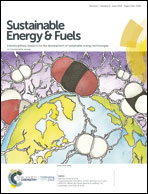Impact of various dopant elements on the properties of kesterite compounds for solar cell applications: a status review
Abstract
Earth-abundant and nontoxic kesterite compounds, such as Cu2ZnSnS4 (CZTS), Cu2ZnSnSe4 (CZTSe), and Cu2ZnSn(S,Se)4 (CZTSSe), have made tremendous progress, becoming a hot topic in optoelectronic materials research on power generation through solar energy capture. These compounds can be considered possible alternatives to conventional, toxic, and expensive absorber layers, such as crystalline silicon (c-Si), Cu(In,Ga)Se2 (CIGS), and CdTe. The p-type semiconductor kesterites (CZTS, CZTSe CZTSSe) are the most promising light absorbers for solar cell applications, reaching record efficiencies of up to 12.7% owing to their unique optical properties. These properties include a variable band gap energy ranging from 1.0 eV (Cu2ZnSnSe4) to 1.5 eV (Cu2ZnSnS4) and a large optical absorption coefficient of 104 cm−1, which make kesterite a feasible option for photovoltaic technologies scalable to terawatt levels. Furthermore, as kesterite absorbers do not contain any rare metals or toxic materials, one can expect their application to low-cost solar cells in the near future. This review aims to present an overview of the most recent research activity on state-of-the-art kesterite-based absorbers, including a brief introduction to kesterite compounds, deposition methods, and improved device performance through doping with alkali, germanium, and other metal elements either during kesterite synthesis or after growth as a post-deposition treatment. As the key component for improving the power conversion efficiency of the kesterite absorber, doping with alkali, germanium, and other metal elements has attracted much interest and is vital for delivering promising efficiencies. Furthermore, current knowledge on doping, its impact on structural, optical, and electrical properties, and the solar cell performance of kesterite compounds are summarized. Finally, important achievements in this field to date and further directions for improving the solar cell efficiency of kesterite-based absorbers have been summarized.



 Please wait while we load your content...
Please wait while we load your content...